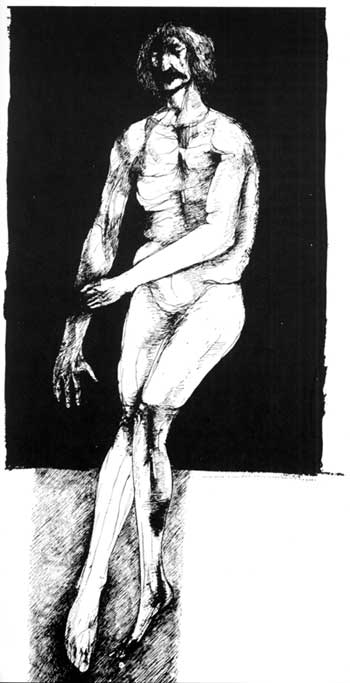|
LITTLE BIGHORN BATTLEFIELD National Monument |
 |

Reno Besieged
Captain Benteen's march had revealed no sign of Indians, and at length he had turned back to the trail made by Custer and Reno, reaching it just in advance of Captain McDougall and the slow-moving packtrain. Here Sergeant Kanipe galloped up with the message from Custer to hasten forward with the packs. Benteen sent him to McDougall. A little later Trumpeter Martini, his horse bleeding from a bullet wound, arrived with the penciled order from Cooke to bring the packs and be quick. The column pushed rapidly down Reno Creek, approaching the Little Bighorn in time to witness the last of Reno's men retreating from the valley. Some of the Crow scouts, whom Custer had released a short time before, directed Benteen to the bluffs on his right, where the remnant of Reno's battalion had gathered. A brief gallop united Benteen's troops with Reno's broken command on top of the bluffs. A short time later the packtrain and its escort labored into the defense lines that Benteen had swiftly formed.
The troops gathered on Reno Hill heard heavy and continuous firing from downstream. Two distinct volleys echoed over the hills. Certain that Custer was engaged, Capt. Thomas B. Weir urged Reno to ride to his support. The major refused, and without authority Weir went by himself, his company following under Lieutenant Edgerly. Later, the rest of the command strung out on Weir's trail. Topping the high pinnacle now known as Weir Point, Weir saw the Custer battlefield 3 miles in the distance, but smoke and dust obscured all details of the activity taking place there. Hundreds of warriors ascending the north slope of Weir Point halted the advance. After a brief skirmish, the soldiers fell back to Reno Hill. Mounting numbers of Sioux pressed from behind, swiftly surrounded the 350 or more troopers and packers, and at once brought them under a deadly fire that did not subside until twilight, 3 hours later.
Nightfall interrupted the siege, and most of the Indians returned to the village for a great war dance illuminated by leaping bonfires. On Reno Hill, the men spent the night digging shallow rifle pits and improvising breastworks from packs and dead animals. The defenses occupied a perimeter enclosing a shallow depression, in which Dr. H. R. Porter, a civilian under army contract, placed his hospital. Major Reno held the north rim with most of the companies. Benteen occupied the south side, an elliptical ridge, with H Company. On the west, the bluffs dropped steeply to the Little Bighorn. On the east a gradual slope fell away to Reno Creek.
With the first hint of dawn, a single rifle shot signaled the resumption of the siege. From all sides the Indians poured a constant stream of arrows and bullets into the defense perimeter. The soldiers responded whenever a target offered itself, but the warriors were adept at drawing fire without getting hit.
Throughout the hot morning the fight continued without letup. The Indians worked themselves ever closer around the lines, taking advantage of the irregular terrain and clumps of sagebrush to avoid exposure. At times they threatened to mass for an attack, especially on Benteen's exposed and thinly held position. The captain strode about in full view, refusing to take cover and disdaining the deadly fire directed at him. On one occasion he roused his men to their feet and led them in a charge that broke up a cluster of warriors preparing for an assault. On another he went to Reno and demanded a general counterattack. Led by the major, the troopers rose from their pits and surged forward to drive back the encircling Sioux and Cheyennes.
Thirst tormented the defenders, especially the wounded in Dr. Porter's hospital. The surgeon served notice that his charges must have water at any hazard. Four sharpshooters stood up to distract the enemy and provide covering fire while a volunteer party slipped down a ravine to the river, filled canteens and camp kettles, and hastened back to the hill. They got little water, but it was enough to afford some relief to the wounded. For this feat, 19 men later received the Congressional Medal of Honor.
Early in the afternoon the siege relaxed, and by late afternoon only an occasional shot reminded the defenders to stay under cover. In the valley, the Indians fired the dry prairie grass. A wall of thick smoke screened the village from view. About 7 p.m. an immense procession of horsemen, women and children on foot, travois, ponies, and dogs emerged from behind the smoke. Slowly it wound up the slope on the west side of the valley and made its way across the benchland to the southwest, toward the peaks of the Bighorn Mountains. Below, the valley appeared deserted save for scattered debris of the great Indian camp.

|
|
Last Modified: Sat, Sep 28 2002 10:00:00 pm PDT |


